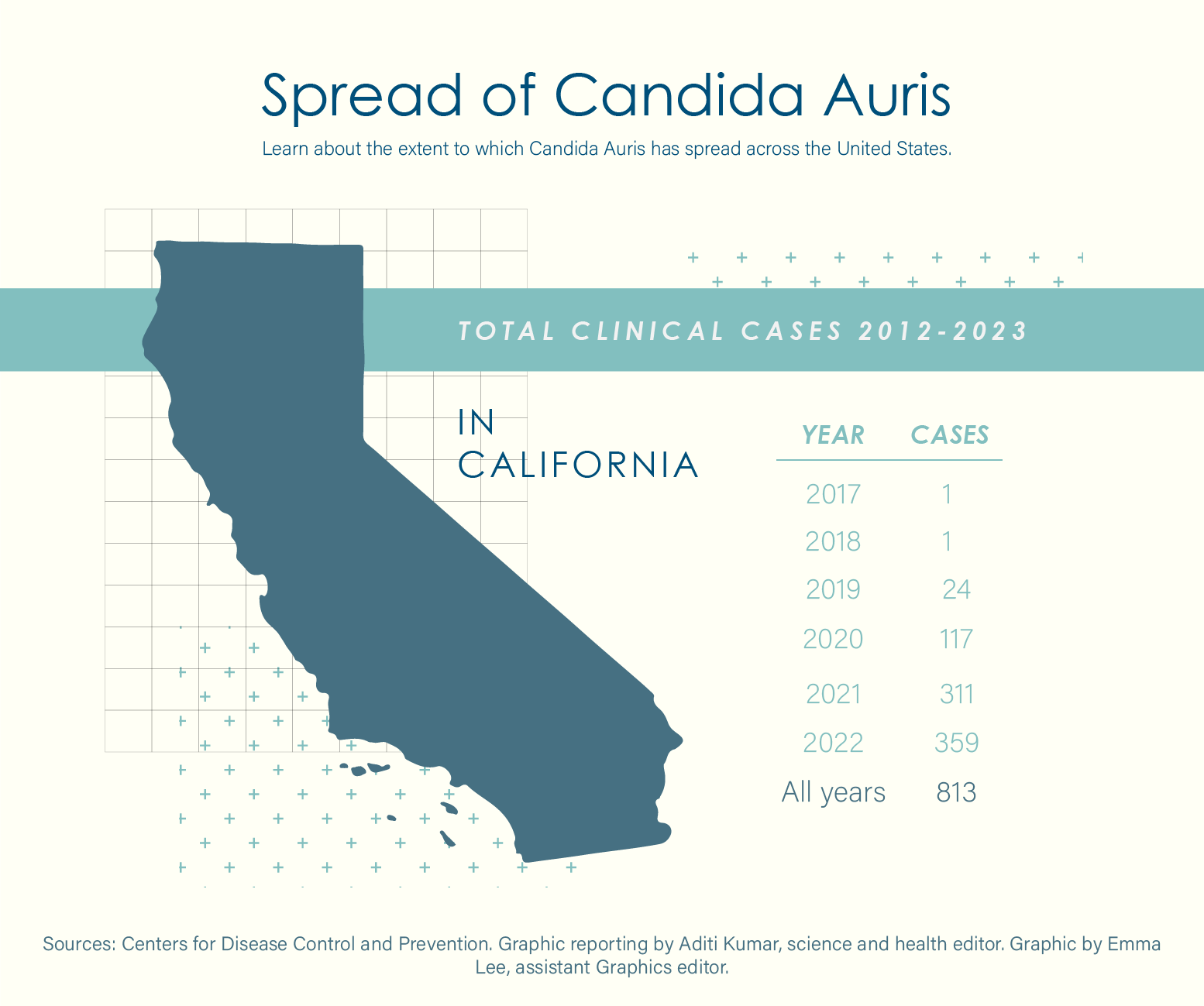Campus Queries: Why is the Candida auris fungus dangerous, and how can we combat it?

By Callie Wiesner
April 16, 2023 9:44 p.m.

Campus Queries is a series in which Daily Bruin readers and staff present science-related questions for UCLA professors and experts to answer.
Q: What is Candida auris, and how does it infect people?
A: Candida auris is a dangerous fungus that has seen a dramatic rise in cases since the pandemic.
The Centers for Disease Control and Prevention issued a warning about the fungus March 20. Officials and experts cautioned that Candida auris can be multidrug resistant, difficult to identify in the laboratory and has caused outbreaks in health care settings, such as hospitals and nursing homes. In regard to its fatality, the Los Angeles County Department of Public Health has recorded 2,377 clinical cases and 5,754 screening cases in the last 12 months in the U.S. with a mortality rate of 30% to 60%. However, many of the fatalities occurred in people who had the fungus in their bloodstream, were immunocompromised and usually had preexisting conditions that inhibited their ability to fight infections.
Michael Yeaman, a professor at the David Geffen School of Medicine and chief of molecular medicine at the Harbor-UCLA Medical Center, said that once the fungus enters the bloodstream, it can spread to other organs and cause immune dysregulation.
If the infection is not controlled, this can lead to sepsis – the body’s extreme response to infection, disrupting the blood vessel barrier and allowing liquid from the blood vessels to enter the tissue and potentially causing organ failure, said Ashraf Ibrahim, a professor at the David Geffen School of Medicine and infectious disease faculty member at the Harbor-UCLA Medical Center. Zachary Rubin, an infectious disease physician and chief of the Healthcare Outreach Unit at the LA County Department of Public Health, said that once sepsis occurs, treatment may or may not be successful. He added that people with sepsis may end up dying.
There are five types of Candida auris that grow throughout the world and exhibit a range of responses to antifungal drugs. For example, LA is dominated by the third type, which is less resistant to antifungal drugs, Rubin said. Different types of Candida auris have come to the United States over time because of the international nature of travel, he added.
Cases of Candida auris have been seen across the U.S., with outbreaks in Orange County nursing homes in 2019 among the first recorded cases in California, Ibrahim said.
The COVID-19 pandemic drew attention away from Candida auris, Rubin said. Infectious disease prevention practices shifted to containing COVID-19, so a lot of the strategies established before the pandemic for Candida auris were less of a priority, Rubin added.
Scott Filler, a professor at the David Geffen School of Medicine and chief of infectious diseases at the Harbor-UCLA Medical Center, said the number of people who have been colonized by the fungus has doubled in the last year.
The CDC stated that when a person is colonized with Candida auris, the fungus is present on their body, but they are not infected with the fungus and are not experiencing symptoms of infection. Candida auris can only infect a person once it has entered their bloodstream.
Individuals are typically colonized by Candida auris through direct contact with living and inanimate objects, Filler said, adding that it can remain on inanimate objects for several weeks. Those who are older or immunocompromised can become infected if it enters the bloodstream, such as through use of catheters or other devices that come into contact with the bloodstream, he added.
Rubin said the CDC has not yet found a reliable method to decolonize people who have been colonized by Candida auris. However, only 5-10% of people in LA County who are colonized with Candida auris become infected with the fungus, he added.
Q: Why is Candida auris difficult to contain and treat?
A: Ibrahim said Candida auris is one of the only multidrug resistant fungi.
Candida auris has regions in its genome where mutations occur when drugs are introduced into the fungus, which allows the fungus to mutate and become resistant to each drug that is used, Yeaman said. The fungus can likely work to resist other drugs it hasn’t seen before based on its known resistance to drugs previously used for treatment, he added.
Candida auris can be resistant to all of the drug classes used to treat fungal infections, making it difficult to treat a patient infected by Candida auris, Ibrahim added.
“When you have an organism that can show its resistance to several classes of drugs, the likelihood that you are going to have resistance to any new drug coming into the pipeline is extremely high,” Ibrahim said. “(A drug) can become obsolete at any certain time against the infection.”
In addition to being difficult to treat, Candida auris outbreaks are difficult to contain, as they spread quickly, Filler said. For example, an immunocompromised person can become infected by Candida auris even if a room was disinfected if it was previously used by an infected person. He added that the fungus is resistant to certain soaps used to clean medical facilities.
Q: What preventative measures or treatments exist for Candida auris?
A: The main modes of infection control for Candida auris include basic measures, such as hand washing and disinfecting spaces known to have Candida auris. There are also more specific measures including contact precautions, such as wearing medical gowns, Rubin said.
Ibrahim said scientists need to develop new drugs to combat Candida auris in humans.
“(Fungal infections have) been very tough to treat because they are eukaryotes, so they have similar structures as mammalian cells,” Ibrahim said. “You really have to hit the sweet spot where you have a drug that really is highly effective against them but also at the same time lacks toxicity against mammalian cells.”
As Candida auris is a relatively new threat, Ibrahim said there is a lack of funding to study the disease, which has led to a low number of antifungal drugs being approved to treat Candida auris. To treat Candida auris effectively, new drugs have to be developed that the fungus has not yet become resistant to and antifungal drugs still need to be used, he added
“Microbes are going to figure out how to resist something, so maybe one of our strategies needs to be to stay just one step ahead,” Yeaman added.
People infected with Candida auris can still be treated using antifungal drugs, depending on the type of Candida auris they have, Rubin said. For example, infections in LA can be treated with the antifungal drug most commonly used for Candida infections, also known as yeast infections, he added.
Once the fungus builds up resistance to one drug class, the doctor has to switch to an older drug class that may not be as effective and could have side effects, Yeaman said.
There are new drugs in development that are showing promise for treating Candida auris that can be administered orally or intravenously, Filler said.
He added that a group in the Lundquist Institute at the Harbor-UCLA Medical Center is developing a vaccine that reduces the level of infection in those who are infected with Candida auris. Filler, Ibrahim and Yeaman are involved in the development of the vaccine. If the vaccine shows promising results, it will be administered to those with a high risk of being colonized and infected with the fungus, including people who regularly enter nursing homes and ICU patients, Ibrahim said.
It is important that treatments to prevent and reduce infection levels are developed as the aging population grows and more people enter nursing homes, where there is a lot of person-to-person contact and many patients may get sick and have to go to the hospital, Filler added.
Candida auris infection rates are still increasing throughout LA County, and these infections matter, Ibrahim said.
“We already know that there are cases happening in ICUs, nursing homes in Los Angeles county as well as Orange County, and they will affect us,” Ibrahim said. “If we don’t really pay attention to it, we’re going to see (more) patients (infected with Candida auris) in our ICUs (and) nursing homes.”

